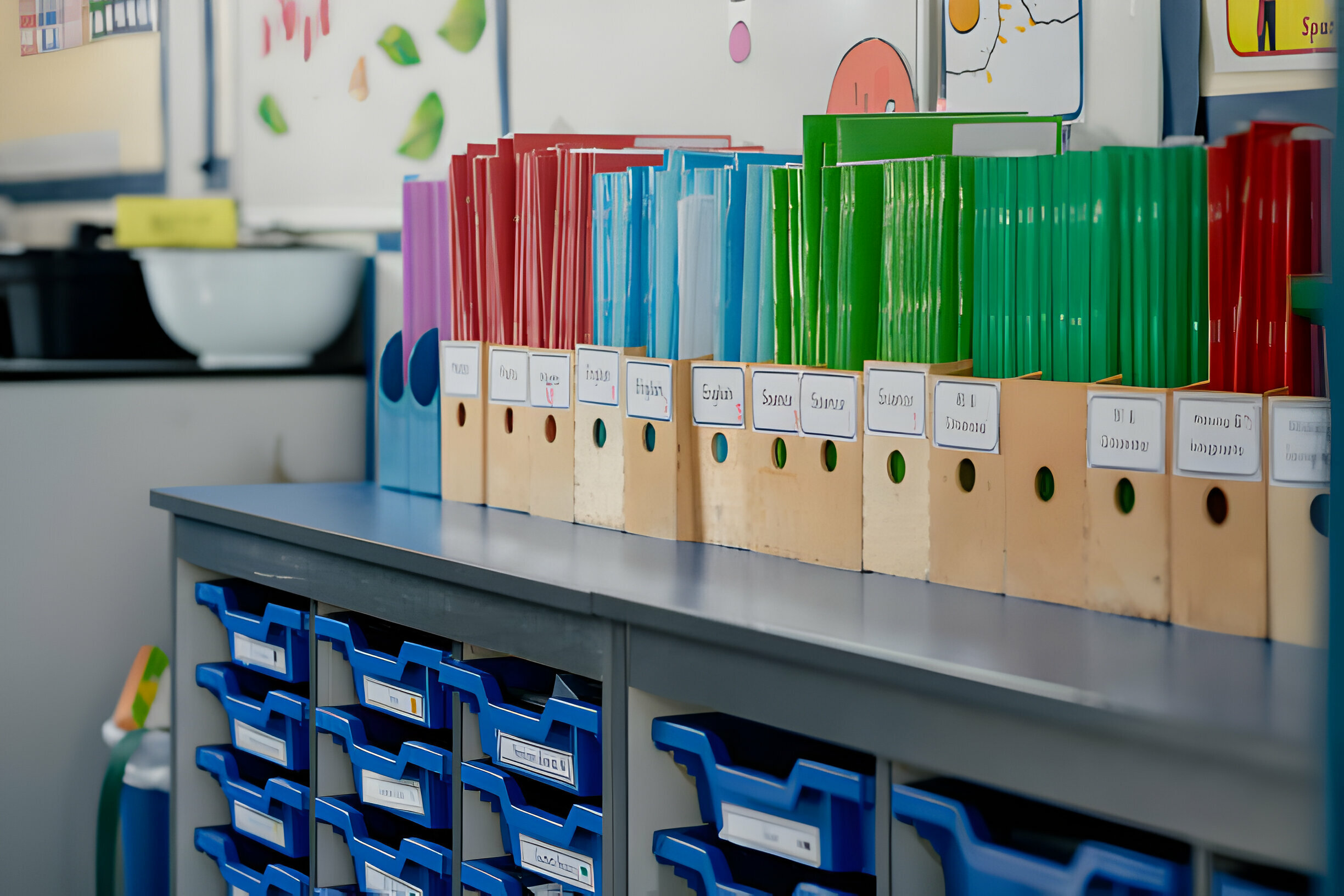Efficient Classroom Organization Strategies
Using storage solutions like bins, binders, and file folders can help create a place for everything and make classroom organization more efficient. Efficient labeling techniques can also play a crucial role in keeping things organized. By utilizing technology tools such as digital activity management apps and online programs, you can streamline your lesson planning and keep track of classroom objects more effectively. Another strategy is to design dedicated zones in your classroom for different activities, which helps maintain order and makes it easier to find materials when you need them. Additionally, implementing checklists for daily tasks can help you stay organized and ensure that everything is completed on time. Lastly, sorting and bundling supplies according to their type can save you time and make it easier to locate specific items when needed.
Step-by-Step Approach to Classroom Organization
To start organizing your classroom step by step, divide the space into different zones and create designated places for everything using storage solutions like bins, binders, and file folders. This will help maximize space and create an efficient storage system. By organizing your classroom in this way, you can create a functional environment that promotes productivity and learning. Consider the layout of your classroom and how you can arrange furniture and materials to optimize the use of space. Additionally, think about incorporating aesthetic decor that not only looks visually appealing but also serves a purpose in organizing your classroom. Remember, taking a systematic approach to organization will make it easier to maintain an organized and clutter-free classroom throughout the year.
| Maximize Space | Efficient Storage | Classroom Layout |
|---|---|---|
| Utilize vertical spaces such as bookshelves or wall-mounted storage units | Use labeled bins or baskets to categorize supplies | Arrange desks or tables in a way that allows for easy movement |
| Remove unnecessary furniture or items to free up space | Utilize binders or file folders to organize paperwork | Create separate areas for different activities (reading area, group work area) |
| Use stackable containers or drawers for compact storage options | Implement a labeling system for easy identification of materials | Ensure there is ample room for student movement and collaboration |
Creative Storage Solutions for Classroom Decor
Spray-paint clothespins can be used to display student work and create a visually appealing classroom. They are not only functional but also add a touch of creativity to your classroom decor. When it comes to creative storage solutions, maximizing space is key. Consider using baskets or Sterilite drawers with labeled fronts to cut down on clutter and keep everything organized. By using numbered bins and designated spots, you can easily store math centers and rotate materials during rotations. Additionally, utilizing a laundry basket or tall trash basket for rolled up anchor charts helps declutter the walls while keeping them accessible. Remember, teaching students to stay organized is important in maintaining a functional layout. Use ziplock bags for small group readers, centers, and other materials to keep everything neat and easy to find. Incorporating these decluttering strategies will help you create an aesthetic environment in your classroom.
Teaching Students the Art of Organization
Teaching students the importance of organization helps you develop essential skills for maintaining a tidy and efficient classroom. By implementing effective teaching strategies and organization techniques, you can enhance student engagement, improve classroom management, and promote better time management. Start by explaining the benefits of organization to your students and model how to keep their desks and materials organized. Incorporate checklists to help them manage their daily tasks and teach them to sort and bundle their supplies. Encourage the use of labeling systems and creative storage solutions, such as using baskets or labeled bins, to keep everything in its place. By teaching your students these valuable organizational skills, you are setting them up for success both inside and outside of the classroom.
Numbering and Color Coding Your Classroom
Color coding and numbering your classroom can help streamline organization and make it easier for students to find what they need. By implementing a numbering system and color coding system, you can create a visually appealing and efficient classroom environment. Here are some organization tips and classroom decor ideas to consider:
- Numbering system:
- Number class rosters, cubbies or mailboxes, earphones, computers, book bins, and other items.
- Have students put their number alongside their name on all papers for easy organization.
- Color coding system:
- Consider color coding anchor charts by subject for quick reference.
- Color code teams or groups of desks and use foam squares as color-coded coasters for water bottles.
Ziploc Bags: Your Secret Organization Weapon
When it comes to organization in your classroom, Ziploc bags can be your secret weapon. Using Ziploc bags for organization offers numerous benefits. They are affordable, durable, and transparent, allowing you to easily see what’s inside. You can use quart-size bags for small group readers, chapter books, and take-home books. Gallon-size bags are perfect for storing centers and master copies of student pages. Get creative by organizing vocabulary cards, science readers, calendar wall pieces, and word wall cards in Ziploc bags. Sandwich-size bags are great for storing student letter cards or magnetic letters for word building. They can even be used to store sets of base ten blocks or discs for guided math groups. With Ziploc bags, you can simplify classroom organization while keeping everything neat and tidy.
Decluttering and Streamlining Your Classroom
Using Ziploc bags for organization can help declutter and streamline your classroom. Here are some decluttering techniques and storage solutions to consider for desk organization and classroom setup in order to create a minimalist classroom:
- Decluttering Techniques:
- Purge unused items before the end of the year.
- Sort out unused items from cupboards, files, and books.
- Donate unwanted items to other teachers.
- Storage Solutions:
- Use quart-size Ziploc bags for small group readers and take-home books.
- Store centers and master copies of student pages in gallon-size Ziploc bags.
- Organize vocabulary cards, science readers, and word wall cards in Ziploc bags.
Using Clothespins and Paperclips for Classroom Decor
Spray-painting clothespins to match your classroom and using them to display student work creates a visually appealing and functional classroom decor. Clothespin crafts and paperclip art are great DIY classroom decor ideas that can add a personal touch to your space. Not only do these decorations look cute, but they also serve a practical purpose in organizing with clothespins. You can use them to hang up student artwork, important papers, or even create a classroom news bulletin board. Get creative with different colors, patterns, and shapes of clothespins to make your classroom truly unique. By incorporating these simple yet effective decoration ideas, you can transform your classroom into an organized and inviting learning environment for your students.
Labeling Your Class Library: Tips and Tricks
Labeling your class library is an effective way to organize books and make it easier for students to find what they are looking for. Here are some efficient labeling techniques and tips for organizing your book bins:
- Utilize parent volunteers: Enlist the help of parent volunteers to assist with labeling. Provide them with a basket of books and clear instructions on how to label each bin.
- Color code library books: Assign a specific color to different genres or reading levels. This will allow students to quickly identify the type of book they are interested in.
To maintain an organized library, remember these key points:
- Regularly check and rearrange the book bins as needed.
- Encourage students to return books to their designated bins after use.
Organizing Instruction for a Smooth Classroom Experience
To ensure a smooth classroom experience, prioritize keeping your curriculum maps and long-range plans easily accessible. Organizing lesson plans is key to staying on track and effectively delivering instruction. Create a system for managing classroom objects, such as bins, binders, or file folders, so everything has a designated place. Utilize daily task checklists to streamline your daily routine and stay organized. These checklists can help you map out when each tool, toy, book, or technology needs to be used throughout the day. Take advantage of digital activity management tools to create and organize lesson plans, seating charts, quizzes, and activities. Additionally, make use of technology resources available in your classroom to enhance organization and efficiency. By utilizing these strategies and resources effectively, you can create an environment that promotes seamless instruction and organization.
Maximizing Space and Layout for Classroom Decor
When maximizing space and layout for your classroom decor, consider rearranging furniture and creating designated areas for different activities. This will help create a functional and organized environment that maximizes storage and utilizes wall space effectively. Here are some strategies to consider:
- Creating a seating plan: Arrange desks or tables in a way that promotes collaboration and engagement.
- Organizing supplies: Use bins, shelves, or drawers to keep supplies neatly organized and easily accessible.
- Sort supplies intelligently based on their purpose (math class, arts and crafts, etc.).
- Label each bin or container to ensure everything has its designated place.
Creating a Functional and Aesthetic Classroom Environment
Make sure you consider the layout and organization of your classroom to create a functional and aesthetically pleasing environment that promotes learning and engagement. Start by organizing your classroom supplies in a way that is easy for both you and your students to access. Use bins, drawers, or shelves to store materials like pencils, markers, and paper. When it comes to decor, aim for a calming atmosphere with soothing colors and natural elements. Consider incorporating student input in the classroom decor by letting them contribute artwork or helping choose decorations. Maximize your classroom space by utilizing vertical storage options like bookshelves or hanging organizers. Remember, the key is to create an environment that is both functional and visually appealing to enhance the overall learning experience for everyone involved.



